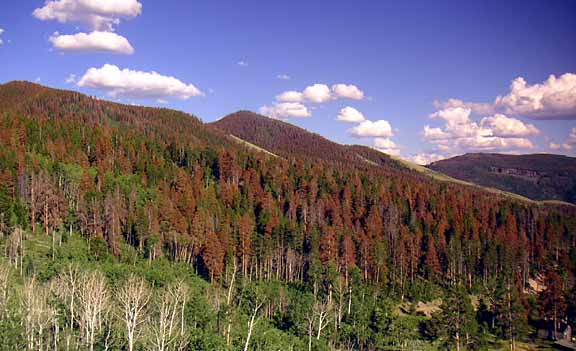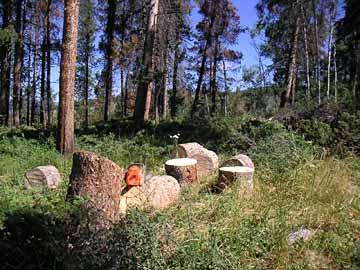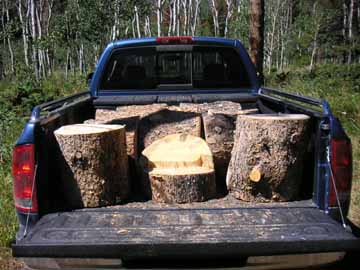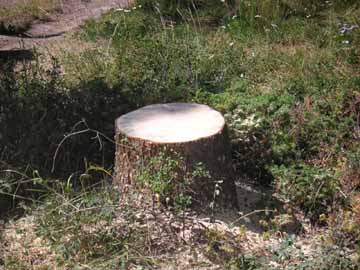THE PINE TREE A recent newspaper article (July 2005) said "80% of Colorado's pine trees will be dead in three years." Various theories of why this is happening are being argued in bars around the Colorado high country. One theory is that the forests have been overprotected from logging and fires, allowing them to became over-populated with mature trees, which the Pine Beetles are attacking. Others claim it has been the five-year drought that has weakened the trees and made them more vulnerable to beetle attack. It's probably a combination of both. To make matters worse, the next most common tree is the Aspen, and many of them are dying from a combination of fungus and drought. I've lost about half the aspens on my 6 acres and about a fourth of the pines. I would have lost more pines but I've been spraying them every summer for the last three years. My property borders the Arapaho National Forest, and about 85% of those trees are dead already. The once green forests are now brown forests, and will soon turn grey as the dead needles fall. Millions of acres of pine trees around Colorado are now dead. In addition to spraying I've been cutting the dead trees and removing them from my property. In the last three years I've hauled 82 truckloads of dead wood to a dumping area where the wood is burned each fall after the ground is covered with snow. That doesn't include all the firewood I've stacked. I figure I'm about half done with cutting dead trees–provided that no more of my trees die. That's not very likely.
As I began the slow process of cutting it up and hauling it away, which required seven truck loads of wood and more than one day of work, I began wondering how old the tree might be. A cursory count of the rings on a section of trunk revealed that it was over 100 years old. That got my attention. Wow! I decided to look more carefully. The outer rings were very close together and I could not accurately count them, but I now knew the tree was at least 120 years old. I suddenly had great respect for this tree I had just cut down–and more than a measure of sadness.
In 1860, Abraham Lincoln had yet to be elected president,
and the Civil war was still a year and a few months from beginning.
When my pine tree started growing there were only 33 states in the
United States. Kansas, West Virginia, Nevada, Nebraska, Colorado, North
Dakota, South Dakota, Montana, Washington, Idaho, Wyoming, Utah, Oklahoma,
New Mexico, Arizona, Alaska and Hawaii were still territories. Colorado,
its home, was not to enter the Union for another sixteen years, and
had only been officially settled two years prior. In its 145 years, I'm sure it had survived many droughts and invasions of beetles and other insects. Within 100 feet of the tree I found evidence of burned logs, so it had survived at least one forest fire in its life, and probably more. The more I thought about this, the more emotions I experienced. Respect, amazement, anger, frustration, regret, helplessness and sadness were all mixed together. I went back out to where the 2' high stump was all that remained, and sat quietly for a while, trying to assimilate all of this. I wasn't able to, and I still have not. I'm having a sign made to put on that stump. It will say, "Born 1860 -- Died 2005." I'm also putting a finish on that tree trunk section and will hang it on my wall with a time-line of its life, starting with the election of Abraham Lincoln as president. Hopefully it will allow others who see it to reflect on its life and provide them with a perspective that is all too rare these days. |

 Recently
I had to cut down the largest pine tree on my property. A lodge pole
pine, it stood majestically next to my driveway, half way up the hill
from the road to my house. The trunk was not that big as trees go,
but its 18" diameter trunk was a challenge for my 14" chain saw. I
didn't want it to fall across my driveway and fence, so I notched
it appropriately and put a rope on it to insure it fell where I wanted.
It started its slow descent, picking up speed as it came crashing down
exactly where I wanted it to fall, taking out a smaller dead pine
in the process.
Recently
I had to cut down the largest pine tree on my property. A lodge pole
pine, it stood majestically next to my driveway, half way up the hill
from the road to my house. The trunk was not that big as trees go,
but its 18" diameter trunk was a challenge for my 14" chain saw. I
didn't want it to fall across my driveway and fence, so I notched
it appropriately and put a rope on it to insure it fell where I wanted.
It started its slow descent, picking up speed as it came crashing down
exactly where I wanted it to fall, taking out a smaller dead pine
in the process. I cut a 2" slice out of the lower trunk and brought
it up to the house. My belt sander made quick work in smoothing one
face of the section, and about an hour of hand sanding brought it to
a finely honed surface. I retrieved my glasses and magnifying glass
and began a meticulous count. The tree was 145 years old. That means
it started growing in 1860.
I cut a 2" slice out of the lower trunk and brought
it up to the house. My belt sander made quick work in smoothing one
face of the section, and about an hour of hand sanding brought it to
a finely honed surface. I retrieved my glasses and magnifying glass
and began a meticulous count. The tree was 145 years old. That means
it started growing in 1860.